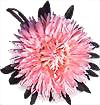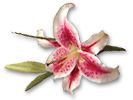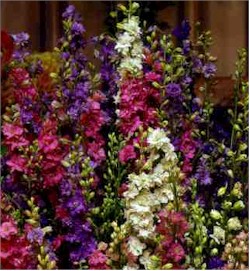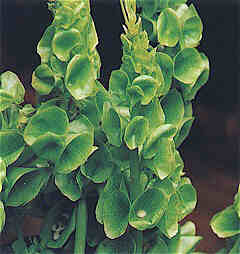 |
Alstroemeria is named after the Swedish botanist Baron Klas
von Alstroemer. This South American flower's seeds were among many collected by von
Alstroemer on a trip to Spain in 1753.
|
 |
The English called asters both asters and
starworts. Aster, Latin for star, referred to the flower's
star-like shape, while wort meant which then applied to plants with healing
properties. There are over 600 species of aster, the most popular being the Monte
|
 |
Botanists are divided on how this remarkable flower got its name.Some maintain that the
flower's brilliant orange and blue blossom,which resembles a bird in flight, is named
after the bird of paradise itself one of the most beautiful bird species in the
world. However, since this flower is also known as the strelitzia, some believe that it
was named after England's Queen Charlotte, who was born Charlotte Mecklenber-Strelitz.
|
 |
Commonly called mums or tansies, this popular perennial's name comes from
the Greek chrysos (gold) and anthos (flower). The Chusan daisy became the pompom
chrysanthemum so called because in France, where it was first grown, it looked like the
pompons on sailors' hats. Chrysanthemums had been cultivated in Chinese gardens for more
than 2,500 years before first being exhibited in England in 1795. Brought by visiting
Buddhist monks, the chrysanthemum arrived in Japan in AD 400.
|
 |
The daisy derived its English name from the Anglo-Saxon term
daes eage, or day's eye, referring to the way this flower opens and closes with the sun.
|
 |
The name gladiolus is derived from the Latin word gladius, meaning sword,
for the shape of its leaves. An ancient name for
the gladiolus was xiphium,from the Greek word xiphos, also meaning sword. African gladioli
were imported in large quantities to Europe from South Africa during the18th century.
|
 |
Native to the tropical Americas and the WesternPacific,the Helconia's
color combination purple-blue fruit, copper banana-like leaves, and anivory or pink
midriff is seen in few other flowers. The H. Psitlacorum heliconia flower is especially
distinctive, for its greenish-yellow flowers and black spots bear a remarkable resemblance
to a parrot's feathers.
|
 |
The lily's name has pre-classical origins indeed it was the Greek name
leirion and the Roman name lilium from which the name lily was derived.
|
 |
While snapdragons were common in the earliest gardens,their actual origin
is not known. Some botanists believe they originally grew wild in Spain and Italy. The
snapdragon's botanical name, antirrhinum, is derived from the Greek anti (like) and rhin
(nose), in reference to the flower's snout-like shape.
|
 |
The tulip is a wildflower said to originate from Persia. In the 1500s,
tulips were extensively cultivated in Turkey, and because of their resemblance to the
tulbend a turban worn by Turkish men were called tulipan. In 1562, tulip bulbs from
Constantinople reached Antwerp by ship. Before the turn of the century, tulips had been
such a rarity that only the wealthy in Holland could afford them consequently, tulips
became a status symbol for the rich. However, by the 1620s, buying and selling tulips
became an activity for merchants, and tulip madness ensued. Tulip trading crashed in 1637,
throwing Holland into financial ruin. After the Dutch government enforced strict laws for
cultivating and selling bulbs, the tulip became the national emblem of Holland.
|
 |
Anthurium flowers consist of a modified, shiny, colorful leaf called
spathe. The spathe is usually heart-shaped, in red, pinks, white and tricolors. The true
flowers are on a cylindrical, long spadix that is usually yellow, but sometimes appear in
other colors. These flowers lend a dramatic focal point and look best when used alone or
with other exotic flowers.
|
 |
From the greek word leimon (meadow), referring to their natural habitat.
Tiny white or yellow flowers are surrounded by papery bracts. Flowers are sessile, in
particles or spikes. Bract colors include white and various shades and tints of pink,
yellow, blue and purple. Useful as a colorfull filler adding interesting texture to mixed
bouquets.
|
 |
Named after a German naturalist, Traugott Gerber. Daysilike flower 3
to 5 inches. Single and double-petaled forms. Available in a wide range of colors and
bicolor patterns, usually with contrasting centers. Stems are hollow and leafless. These
flowers have many uses. Can easily provide a focal point or add mass. Useful in
traditional and contemporary design styles.
|
 |
This cottage garden essential grows up to 3 feet high. Though
perennials in cool climates, they are best grown as annuals in warm areas. Use them as
background plants in mixed borders or massed where height is needed. Flowers appear in
spring and early summer in warm zones and mid to late summer in cooler areas. They are
delightful cutflowers. Cut when the lowest flowers are fully open and the top buds are
starting to show color. The plants prefer full sun but tolerate half a day of sun. Provide
shelter from strong wind, otherwise they will require staking. Soil should be
well-composted and well-drained.
|
 |
Is a lightly scented plant that grows 24 to 36 inches tall. The popular
names alluding to Ireland have been applied to this plant only because of the green color
of the bells, not because the plant comes from Ireland it is native to the eastern
Mediterranean region, primarily Syria.
|
